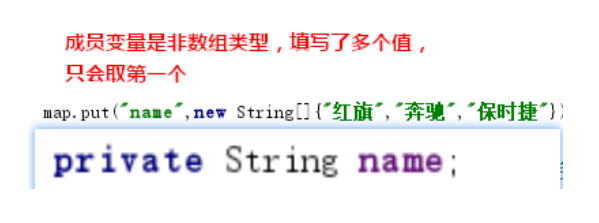BeanUtils
1, Introduction & Overview & Introduction
BeanUtils make it easier and faster to encapsulate JavaBean data.
For example, it can be used in band parameter construction, Set method, reflection.
Getting started:
Import jar package:

public static void main(String[] args) throws Exception { //Populating Phone objects with data using the BeanUtils tool //1. Create Phone object Phone p = new Phone(); //2. Fill in data: setproperty (the object to be filled in, the member variable to be filled in, and the data to be filled in); BeanUtils.setProperty(p,"brand","HUAWEI");//p.setBrand("Huawei"); BeanUtils.setProperty(p,"price",8000.0); BeanUtils.setProperty(p,"color","blue"); //3. Get data: getproperty (which object to get data from and which member variable data to get); System.out.println(BeanUtils.getProperty(p,"brand"));// p.getBrand(); }
Be careful:

2, Advanced use: fill JavaBean with Map [key]
The Map collection populates the JavaBean.
Map < string, string [] >
Map<String,Object>
- Fill in simple data:
Class Car:
public class Car implements Serializable { private String name; private double price; //Ignore other methods }
Class Demo:
public static void main(String[] args) throws Exception { //Map populating JavaBean s //1. Create a Map collection, which stores data Map<String, String[]> map = new LinkedHashMap<>(); //Map key must be consistent with JavaBean's member variables map.put("name",new String[]{"red flag"}); map.put("price",new String[]{"400000"}); //2. Creating JavaBean objects Car car = new Car(); //3. Fill in data: populate (which object to fill in data, map set); BeanUtils.populate(car,map); System.out.println(car); }
- Fill in complex data: array
Class Car
public class Car implements Serializable { private String name; private double price; private String[] doors; //Ignore other methods }
Class Demo:
public static void main(String[] args) throws Exception { //Map populating JavaBean s //1. Create a Map collection, which stores data Map<String, String[]> map = new LinkedHashMap<>(); //Map key must be consistent with JavaBean's member variables map.put("name",new String[]{"red flag"}); map.put("price",new String[]{"400000"}); map.put("doors",new String[]{"Cab door","Auxiliary door","Trunk door"}); //2. Creating JavaBean objects Car car = new Car(); //3. Fill in data: populate (which object to fill in data, map set); BeanUtils.populate(car,map); System.out.println(car); }
matters needing attention:
- The key of the Map must be consistent with the name of the member variable (if not, ignore the corresponding member variable and do not fill in it)
2. If data conversion is required during filling: String can be converted to basic data type (integer, decimal, Boolean, character)
3. Member variable is a non array type. If multiple values are filled in, only the first one will be taken

3, Advanced use: Date Converter [key]
Date class: java.util.Date
Map :String =====>Date
Cast:

Solution:
Class Person:
public class Person implements Serializable{ private String name; private Date birthday; //Other methods ignored }
Class Demo:
public static void main(String[] args) throws Exception { //1. Define Map set and save data LinkedHashMap<String, String[]> map = new LinkedHashMap<>(); map.put("name",new String[]{"Zhang San"}); map.put("birthday",new String[]{"2001-10-01"}); //2. Create Person object Person p = new Person(); //Register a date converter and bind java.util.Date with the date converter //1. Create Date Converter DateConverter dc = new DateConverter(); //2. Format match dc.setPatterns(new String[]{"yyyy-MM-dd","yyyy-MM-dd HH:mm:ss","yyyy/MM/dd"}); //3. Binding: java.util.Date and Date Converter //register registration / binding ConvertUtils.register(dc,java.util.Date.class); //3. Fill in data BeanUtils.populate(p,map); System.out.println(p); }
- Set the matching format
- Must bind before populating data
4, Extended use: Custom MyBeanUtils
Define a Java class: MyBeanUtils
Requires writing a method: populate
1. The method is required to be static and can be called directly through the class name.
2. Define the generic T on the method.
3. The return value type is required to be T type
4. Method parameter: class < T > object
Map < string, string [] > object
5. Create the JavaBean instance object through the Class object passed in, and fill the data in the Map into the JavaBean.
Finally, return the JavaBean object filled with data
Code implementation:
/** * Fill data method * @param clazz Class object of JavaBean to be filled * @param map Save the data to be filled * @param <T> return type * @return Return the JavaBean object filled with data * @throws Exception Exception not handled internally, all thrown */ public static <T> T populate(Class<T> clazz,Map<String,String[]> map) throws Exception { T t = null; //Create the JavaBean object passed in to clazz t = clazz.newInstance(); //Fill data (Date Converter) //Bind Date Converter DateConverter dc = new DateConverter(); dc.setPatterns(new String[]{"yyyy-MM-dd"}); ConvertUtils.register(dc,java.util.Date.class); //Fill data BeanUtils.populate(t,map); //Return JavaBean object return t; }
Today's summary:
| BeanUtils: to simplify the encapsulation of JavaBean data
Setproperty (object, property name, property value)// Getproperty (object, "property name"); Populate (object, map);
Map<String,String[]> Map<String,Object>
2. String ======= Date set Date converter
Date Converter settings: must be set before filling
//1. Create Date Converter DateConverter dc = new DateConverter(); //2. Format match dc.setPatterns(new String[]{"yyyy-MM-dd"}); //3. Binding Date Converter with java.util.Date ConvertUtils.register(dc,java.util.Date.class); |
|---|
Please give yourself a compliment!
Make a little progress every day`~~~~~